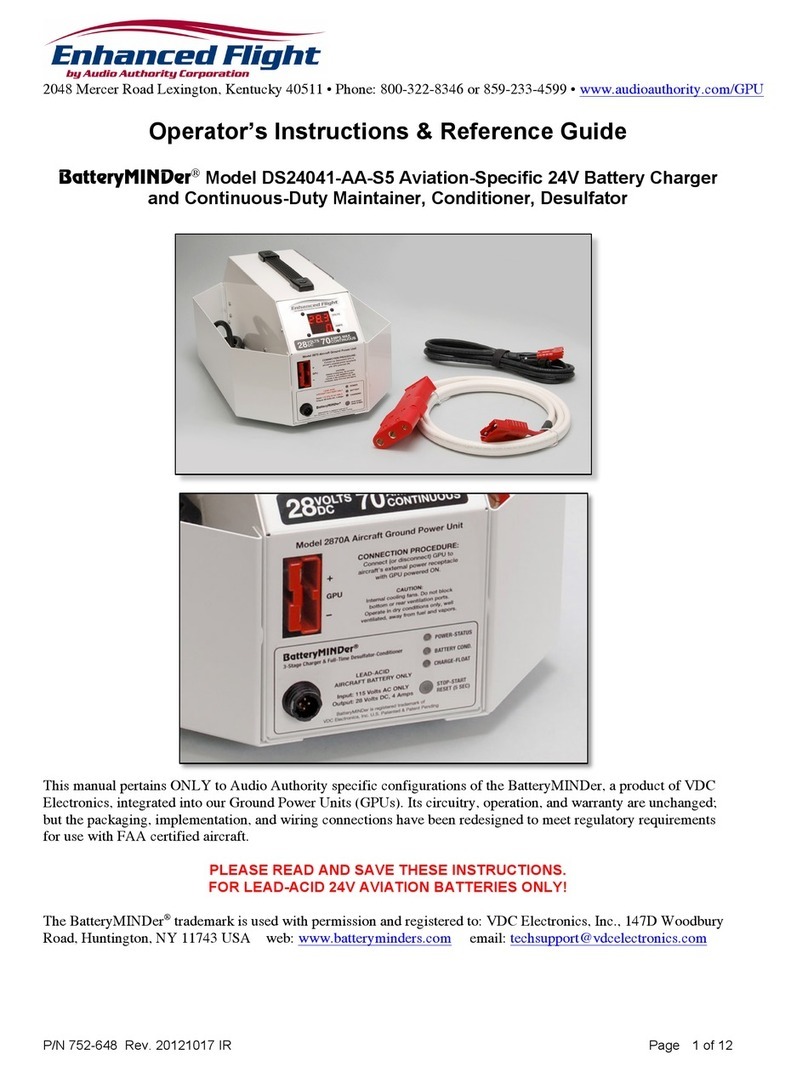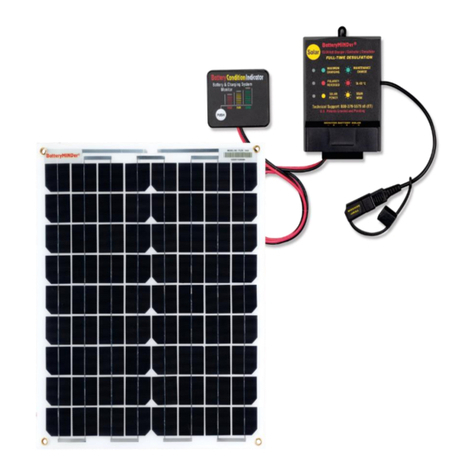BatteryMINDer 128CEC1 User manual

READ AND SAVE THESE
INSTRUCTIONS
VDC Electronics, Inc. •155 W. Carver St., Ste. 2 • Huntington, NY 11743
BatteryMINDer®
12-Volt 128CEC1 and 24-Volt 244CEC1
Battery Maintainer-Desulfators*
Quick Start and Safety Manual
All Models Include:
• ATS Temperature Sensor (installed)
• Ring Terminals with 15A Fuse
• Insulated Battery Clip cordset with quick connect plug
*NOT for use with Aviation-type batteries
A complete detailed instruction manual can be found on
BatteryMINDers.com. Go to Support.
Rev. A2-010516 P/N VDC128/244-CEC1-QSS
VDC244CEC1 LABEL ---P/N 701-100478-01-R

BatteryMINDer® Models 128CEC1 & 244CEC1
Rev. A2-010516 Page 2 P/N VDC128/244-CEC1-QSS
A. WARNING: RISK OF EXPLOSIVE GASES
WORKING IN VICINITY OF A LEAD-ACID BATTERY IS DANGEROUS.
BATTERIES GENERATE EXPLOSIVE GASES DURING NORMAL
BATTERY OPERATION. FOR THIS REASON, IT IS OF UTMOST
IMPORTANCE THAT YOU FOLLOW THE INSTRUCTIONS ON (1) BATTERY
CHARGER, (2) BATTERY AND (3) PRODUCT USING BATTERY EACH
TIME YOU USE THE CHARGER.
1. To reduce risk of battery explosion, follow these instructions and those
published by manufacturer of any equipment you intend to use in vicinity
of battery. Review cautionary marking on these products and on engine.
2. To reduce risk of injury, charge only lead acid type rechargeable batteries.
Other types of batteries may burst causing personal injury and damage.
3. Do not expose charger to rain or snow.
4. Use of an attachment not recommended or sold by VDC Electronics may
result in a risk of fire, electric shock, or injury to persons.
5. To reduce risk of damage to electric plug and cord, pull by plug rather than
cord when disconnecting charger. Make sure cord is located so that it
will not be stepped on, tripped over, or otherwise subjected to damage or
stress.
6. An extension cord should not be used unless absolutely necessary. Use
of improper extension cord could result in a risk of fire and electric shock.
If an extension cord must be used, make sure:
a. That pins on plug of extension cord are the same number, size, and shape
as those of plug on charger;
b. Not to operate charger with damaged cord or plug – replace the cord or
plug immediately.
c. That extension cord is properly wired and in good electrical condition; and
d. That wire size is large enough for AC ampere rating of charger as specified
in Recommended Minimum AWG Size Table.
Recommended Minimum AWG size for Extension Cords For Battery
Chargers
AC input rating, amperes AWG size of cord
Equal to or
greater than
But less
than
Length of cord, feet
25 50 100 150
0 2 18 18 18 16
IMPORTANT SAFETY INSTRUCTIONS - SAVE THESE INSTRUCTIONS
This manual contains important safety and operating instructions for all
BatteryMINDer battery chargers unless otherwise specied.

BatteryMINDer® Models 128CEC1 & 244CEC1
Rev. A2-010516 Page 3 P/N VDC128/244-CEC1-QSS
e. Do not operate charger with damaged cord or plug – replace the cord or
plug immediately.
f. Do not operate charger if it has received a sharp blow, been dropped, or
otherwise damaged in any way.
7. Do not disassemble charger; call VDC Electronics Tech Support Dept.
800.379.5579 x6 (ET) for advice when service or repair is required.
Incorrect reassembly may result in a risk of electric shock or fire.
8. To reduce risk of electric shock, unplug charger from outlet before
attempting any maintenance or cleaning.
B. PERSONAL PRECAUTIONS
1. Consider having someone close enough by to come to your aid when you
work near a lead-acid battery.
2. Have plenty of fresh water and soap nearby in case battery acid contacts
skin, clothing, or eyes.
3. Wear complete eye protection and clothing protection. Avoid touching eyes
while working near battery.
4. If battery acid contacts skin or clothing, wash immediately with soap and
water. If acid enters eye, immediately flood eye with running cold water for
at least 10 minutes and get medical attention immediately.
5. NEVER smoke or allow a spark or flame in vicinity of battery or engine.
6. Be extra cautious to reduce risk of dropping a metal tool onto battery. It
might spark or short-circuit battery or other electrical part that may cause
explosion.
7. Remove personal metal items such as rings, bracelets, necklaces, and
watches when working with a lead-acid battery. A lead-acid battery can
produce a short-circuit current high enough to weld a ring or the like to
metal, causing a severe burn.
8. Use charger for charging a LEAD-ACID battery only. It is not intended to
supply power to a low voltage electrical system other than in a starter-motor
application. Do not use battery charger for charging dry-cell batteries that
are commonly used with home appliances. These batteries may burst and
cause injury to persons and damage to property.
9. NEVER charge a frozen battery or a battery at a temperature above 123° F.
C. PREPARING TO CHARGE
1. If necessary to remove battery from vehicle to charge, always remove
grounded terminal from battery first. Make sure all accessories in the
vehicle are off, so as not to cause an arc.
2. Be sure area around battery is well ventilated while battery is being
charged.
3. Clean battery terminals. Be careful to keep corrosion from coming in
contact with eyes.

BatteryMINDer® Models 128CEC1 & 244CEC1
Rev. A2-010516 Page 4 P/N VDC128/244-CEC1-QSS
4. Add distilled water in each cell until battery acid reaches level specified
by battery manufacturer. Do not overfill. For a battery without removable
cell caps, such as valve regulated lead acid batteries, carefully follow
manufacturer’s recharging instructions.
5. Study all battery manufacturer’s specific precautions while charging and
recommended rates of charge.
6. Determine voltage of battery by referring to car owner’s manual and make
sure it matches output rating of battery charger.
D. CHARGER LOCATION
1. Locate charger as far away from battery as DC cables permit.
2. Never place charger directly above battery being charged; gases from
battery will corrode and damage charger.
3. Never allow battery acid to drip on charger when reading electrolyte
specific gravity or filling battery.
4. Do not operate charger in a closed-in area or restrict ventilation in any way.
5. Do not set a battery on top of charger.
6. Always mount units in vertical position with cord sets exiting downward
to ensure weather tight integrity. Unit must be mounted in this manner
to ensure long term trouble free life including weatherproof integrity.
Mounting in any other manner or using un-mounted (parallel to ground)
except indoors may cause unit to fail due to water intrusion that is unable
to drain correctly.
E. DC CONNECTION PRECAUTIONS
1. Connect and disconnect DC output clips only after removing ac cord from
electric outlet. Never allow clips to touch each other.
2. Attach clips to battery and chassis as indicated in Section G.
F. FOLLOW THESE STEPS WHEN BATTERY IS INSTALLED IN VEHICLE.
A SPARK NEAR BATTERY MAY CAUSE BATTERY EXPLOSION.
TO REDUCE RISK OF A SPARK NEAR BATTERY:
1. Position AC and DC cords to reduce risk of damage by hood, door, or
moving engine part.
2. Stay clear of fan blades, belts, pulleys, and other parts that can cause
injury to persons.
3. Check polarity of battery posts. POSITIVE (POS, P, +) battery post usually
has larger diameter than NEGATIVE (NEG, N,–) post.
4. Determine which post of battery is grounded (connected) to the chassis.
If negative post is grounded to chassis (as in most vehicles), see (5). If
positive post is grounded to the chassis, see (6).
5. For negative-grounded vehicle, connect POSITIVE (RED) clip from battery
charger to POSITIVE (POS, P, +) ungrounded post of battery. Connect
NEGATIVE (BLACK) clip to vehicle chassis or engine block away from

BatteryMINDer® Models 128CEC1 & 244CEC1
Rev. A2-010516 Page 5 P/N VDC128/244-CEC1-QSS
battery. Do not connect clip to carburetor, fuel lines, or sheet-metal body
parts. Connect to a heavy gage metal part of the frame or engine block.
6. For positive-grounded vehicle, connect NEGATIVE (BLACK) clip from
battery charger to NEGATIVE (NEG, N, –) ungrounded post of battery.
Connect POSITIVE (RED) clip to vehicle chassis or engine block away
from battery. Do not connect clip to carburetor, fuel lines, or sheet-metal
body parts. Connect to a heavy gage metal part of the frame or engine
block.
7. When disconnecting charger, disconnect AC cord, remove clip from vehicle
chassis, and then remove clip from battery terminal.
8. See operating instructions for length of charge information.
G. FOLLOW THESE STEPS WHEN BATTERY IS OUTSIDE VEHICLE. A
SPARK NEAR THE BATTERY MAY CAUSE BATTERY EXPLOSION.
TO REDUCE RISK OF A SPARK NEAR BATTERY:
1. Check polarity of battery posts. POSITIVE (POS, P, +) battery post usually
has a larger diameter than NEGATIVE (NEG, N, –) post.
2. Attach at least a 24-inch-long 6-gauge (AWG) insulated battery cable to
NEGATIVE (NEG, N, –) battery post.
3. Connect POSITIVE (RED) charger clip to POSITIVE (POS, P, +) post of
battery.
4. Position yourself and free end of cable as far away from battery as possible
– then connect NEGATIVE (BLACK) charger clip to free end of cable.
5. Do not face battery when making final connection.
6. When disconnecting charger, always do so in reverse sequence of
connecting procedure and break first connection while as far away from
battery as practical.
7. A marine (boat) battery must be removed and charged on shore. To charge
it on board requires equipment specially designed for marine use.
QUALIFYING YOUR BATTERY:
Preliminary Requirements
NOTE: The BatteryMINDer has no electrical output unless it is connected to
a healthy battery. Testing the BatteryMINDer with a volt or an Amp meter
without the unit being connected across a good battery will result in a false
reading. If you experience any problems, or are not sure of how to properly
use or connect your BatteryMINDer, please e-mail our technical support at:
800-379-5579 x6 (ET). Be certain to leave your phone number with the
area code, time zone and the best time to call. To gain the best result from
your new charger and to maximize the life and performance of your batteries
we strongly recommend you qualify (test) your batteries before attempting
to either charge-maintain or desulfate them. Remember, even if you just
This manual suits for next models
1
Table of contents
Other BatteryMINDer Batteries Charger manuals
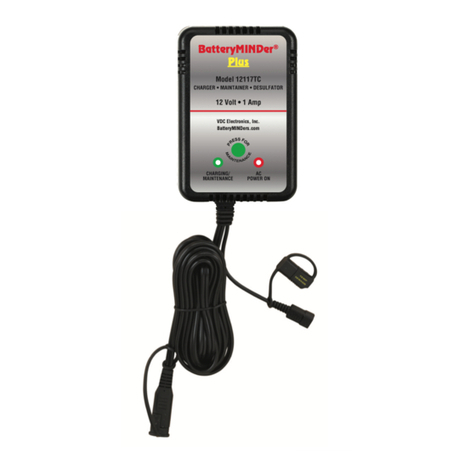
BatteryMINDer
BatteryMINDer Plus 12117TC User manual
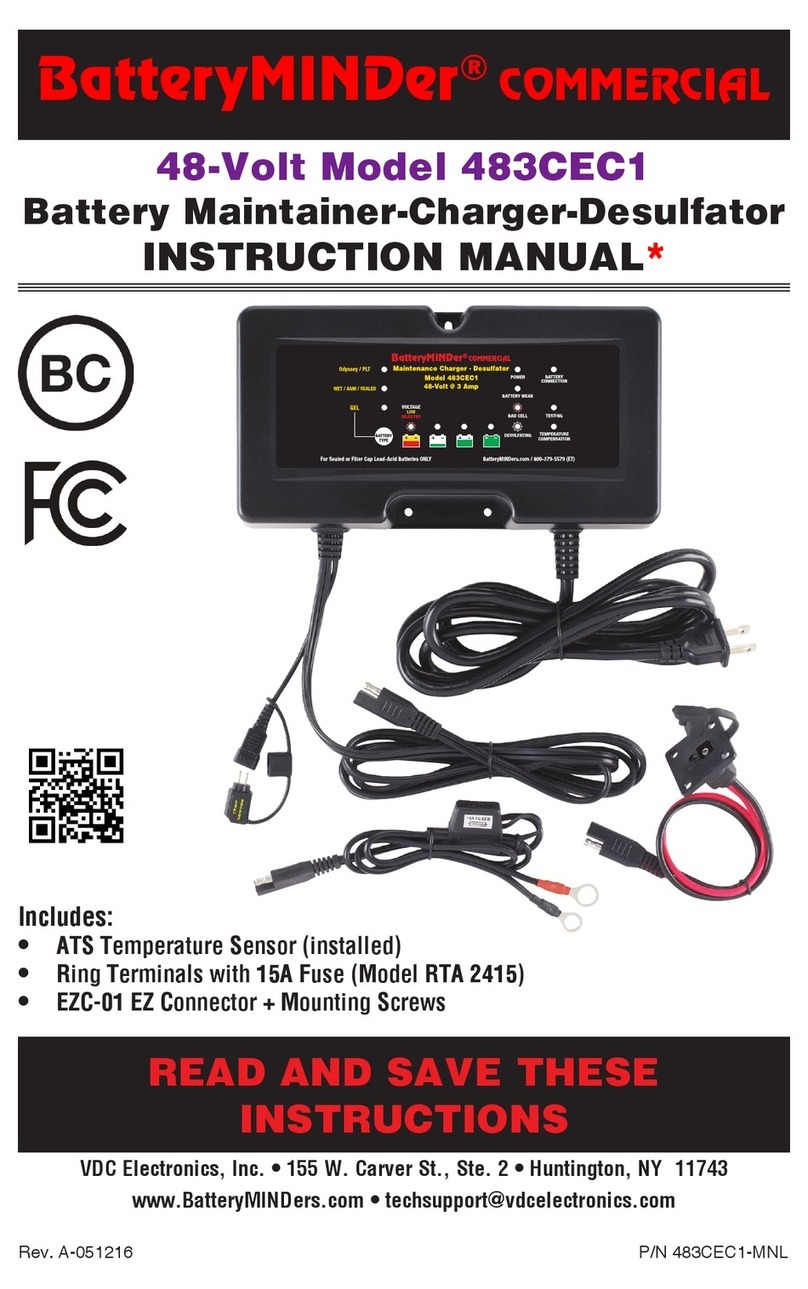
BatteryMINDer
BatteryMINDer 483CEC1 User manual
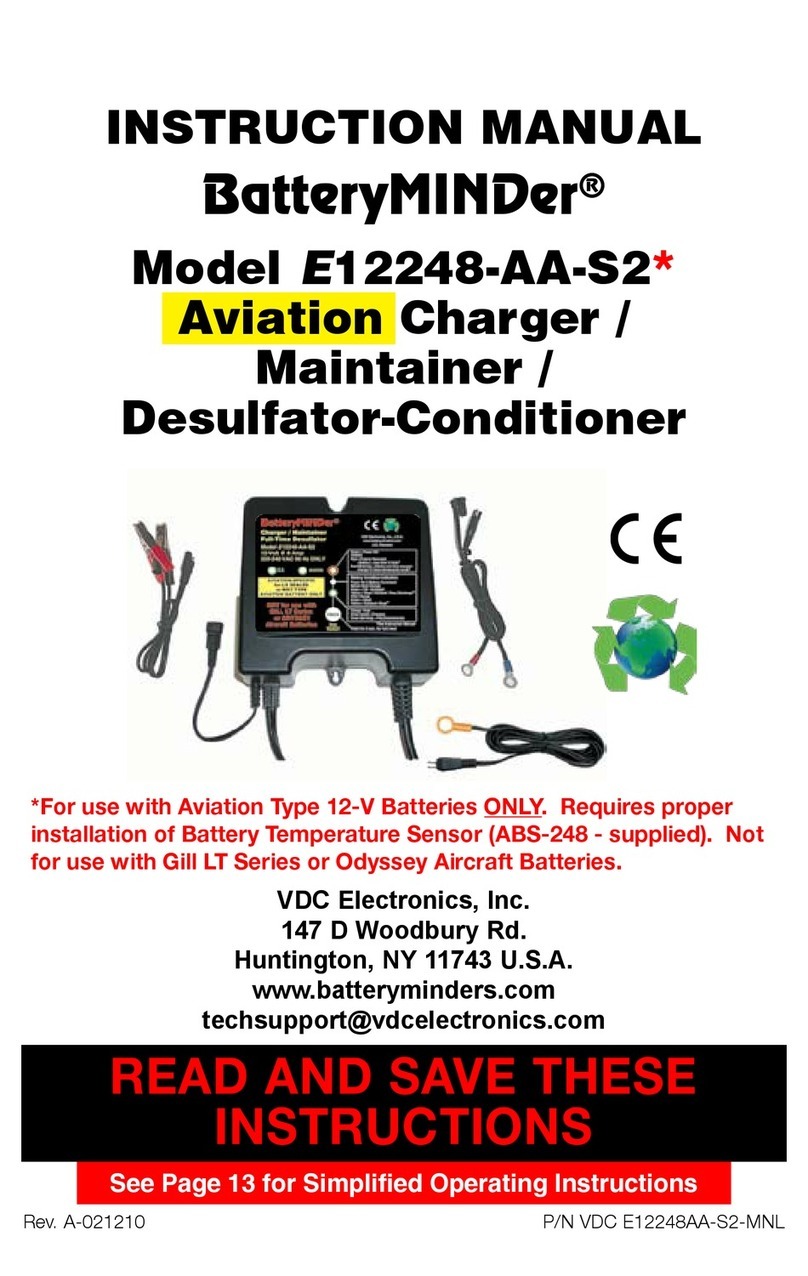
BatteryMINDer
BatteryMINDer E12248-AA-S2 User manual
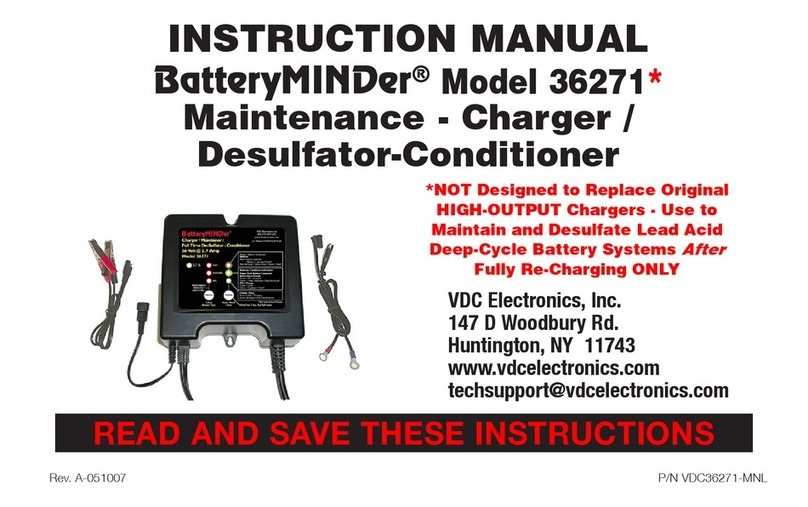
BatteryMINDer
BatteryMINDer BatteryMINDer 36271 User manual
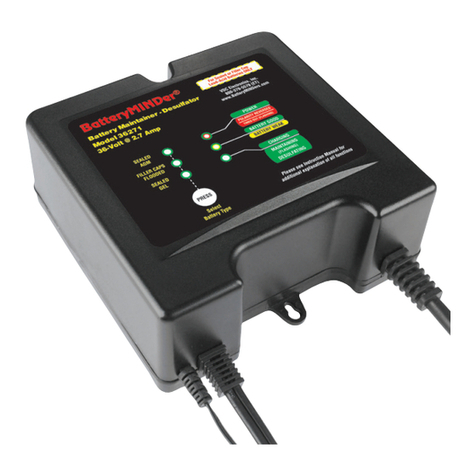
BatteryMINDer
BatteryMINDer BatteryMINDer 36271 User manual
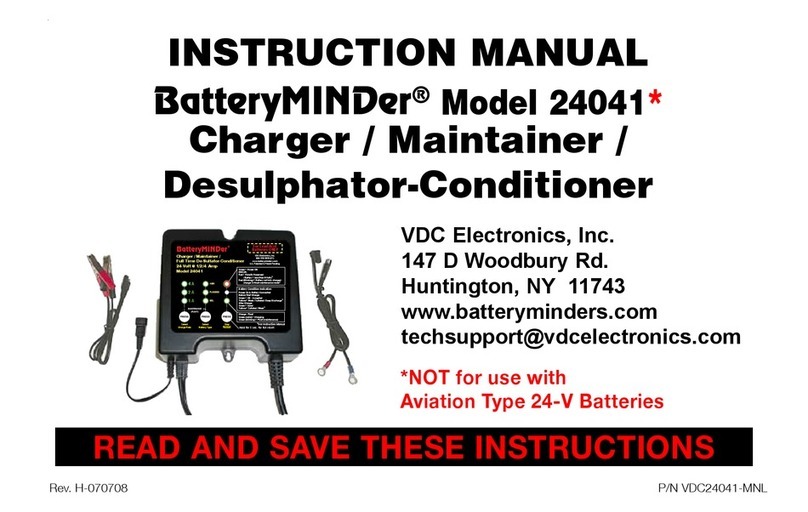
BatteryMINDer
BatteryMINDer 24041 User manual
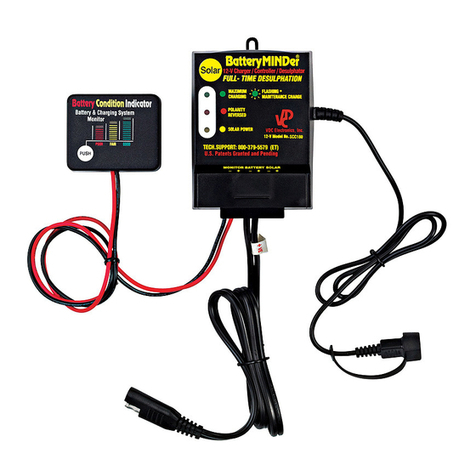
BatteryMINDer
BatteryMINDer SCC180 User manual
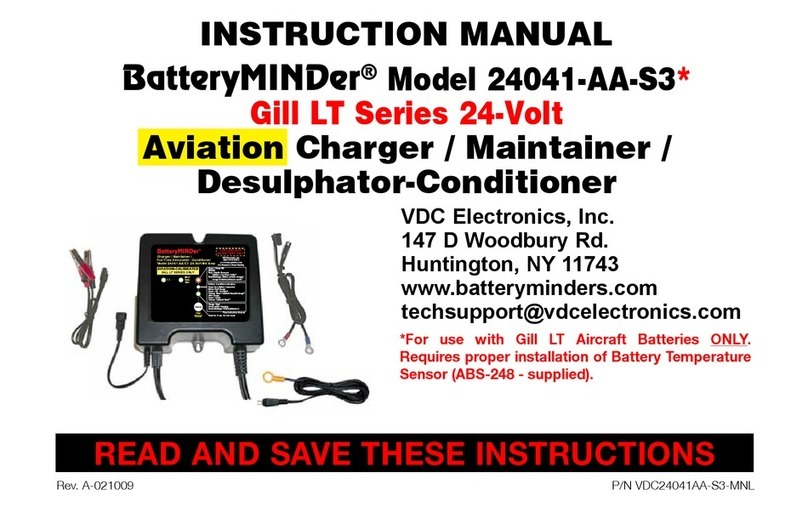
BatteryMINDer
BatteryMINDer 24041-AA-S3 User manual
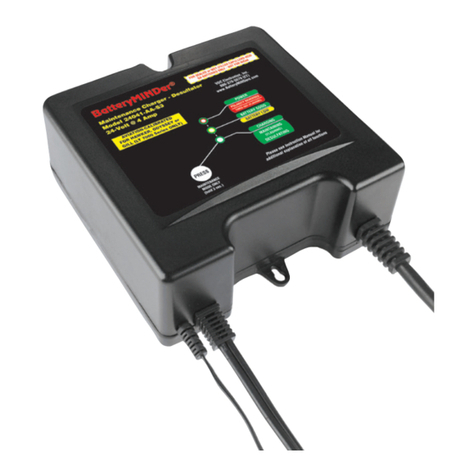
BatteryMINDer
BatteryMINDer 24041-AA Series User manual
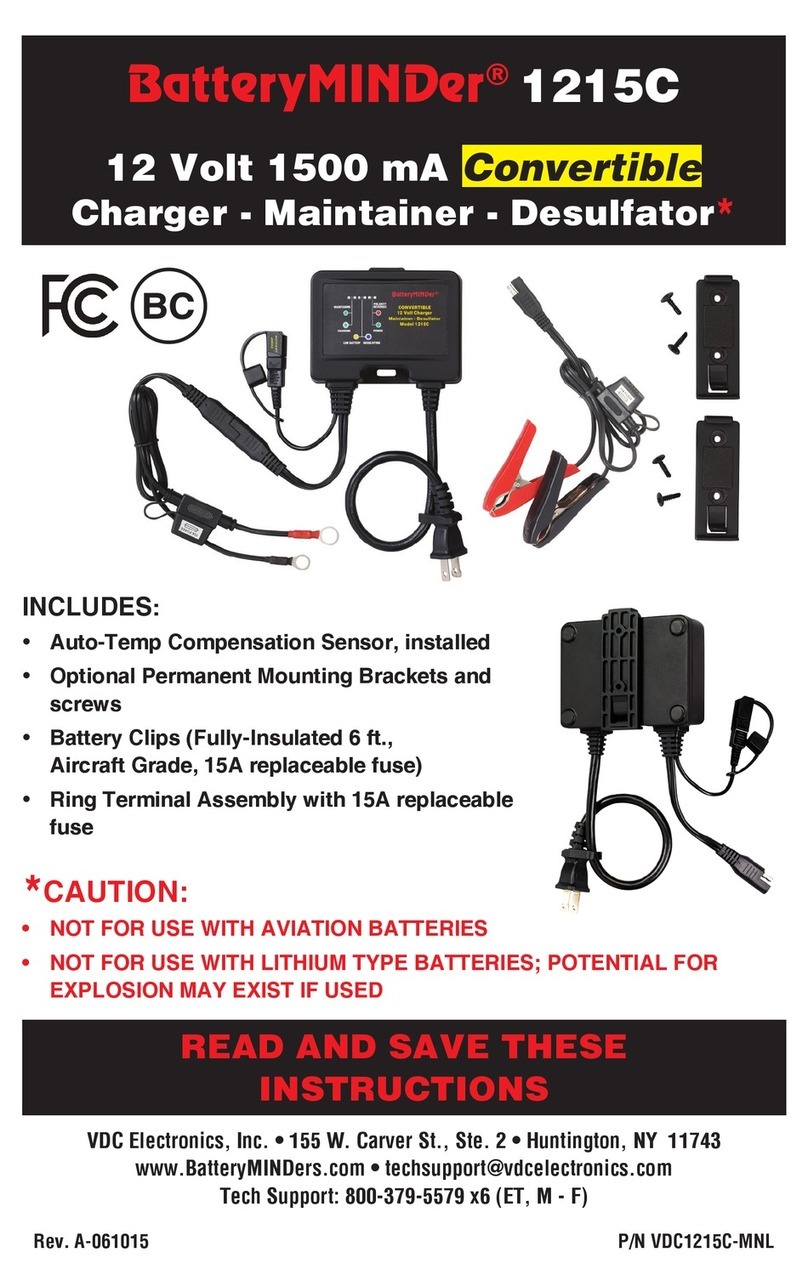
BatteryMINDer
BatteryMINDer 1215C User manual
